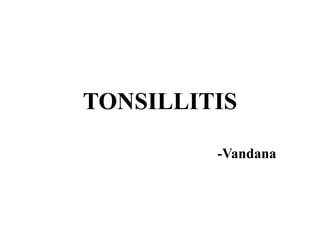
TONSILLITIS
- 2. The tonsils Tonsils are subepithelial collections of lymphoid tissue scattered in the pharynx. Anatomically the tonsils are classified based on their location into : palatine (faucial), nasopharyngeal (“adenoids”), lingual and tubal tonsils. Generally, the palatine tonsils referred to as “the tonsils”.
- 3. The Waldeyer’s ring is formed by : 1. Palatine tonsils 2. Nasopharyngeal tonsil 3. Lingual tonsils 4. Tubal tonsils 5. Lateral pharyngeal bands 6. Posterior pharyngeal nodules
- 4. Embryology The tonsils develop from the second pharyngeal pouch. In the extraembryonic life, the ventral part of the 2nd pharyngeal pouch is represented by crypta magna or intratonsillar cleft.
- 5. Anatomy of tonsils *Site: lateral walls of oropharynx, between the anterior and posterior pillars- tonsillar fossa *Shape: almond shape *2 surfaces: medial, lateral *2 poles: upper, lower * 10-12 primary crypts, secondary crypts *Plica semilunaris and plica triangularis
- 6. Relations Anterior: anterior pillar Posterior: posterior pillar Superior: soft palate Inferior: tongue Medial: cavity of the oropharynx Lateral: loose areolar tissue, paratonsillar veins, superior constrictor, buccopharyngeal fascia, glossopharyngeal nerve, facial artery, pterygoid muscles and the mandible.
- 7. Transverse section showing right tonsil from above
- 8. Blood Supply and Venous Drainage Blood supply - Tonsillar branch of facial artery - Ascending pharyngeal artery - Descending lingual artery - Greater palatine artery Venous drainage: paratonsillar vein pharyngeal plexus of veins
- 9. Lymphatic drainage: The tonsils do not have any afferent vessels but has efferents which drain into the Jugulo- digastric nodes. Nerve supply: Glossopharyngeal nerve and lesser palatine nerves.
- 10. Histology - True fibrous capsule - Fibrous septa - Crypts lined by stratified squamous epithelium - Lymphoid nodules: germinal centres – B cells and plasma cells; surrounded by T cells.
- 11. Functions of Tonsils 1. Immunity 2. Lymphocyte formation 3. Antibodies formation 4. Barrier to infections
- 12. What is tonsillitis ? Tonsillitis is inflammation of the tonsils most commonly caused by a viral or bacterial infection.
- 13. Types Acute tonsillitis Chronic tonsillitis Tonsillitis is often labelled as acute, sub-acute, or chronic. Acute tonsillitis tends to be bacterial or viral in nature, while sub-acute tonsillitis is caused by the bacterium Actinomyces. Chronic tonsillitis generally lasts for a long time and is caused by bacteria. Sub-acute
- 14. Acute Tonsillitis - Acute infection of the tonsils involving the surface epithelium, crypts and lymphoid tissue Acute superficial tonsillitis Acute follicular tonsillitis Acute parenchymatous tonsillitis Acute membranous tonsillitis
- 15. Predisposing factors Endogenous - URTI - Postnasal discharge due to sinusitis - Residual tonsillar tissue after tonsillectomy - Exanthemata - Blood dyscrasias Exogenous - Cold drinks and foods - Contact with infected persons - Crowded and ill- ventilated environment - Imbedded foreign body
- 16. Etiology Although tonsillitis can occur at any age, school-going children are much more likely to suffer from the condition. In fact, tonsillitis is more common in an environment where people are in close contact and germs can be easily spread. *Haemolyticus streptococcus *Staphylococci *Pneumococci *H.influenzae Primary infection Secondary infection
- 17. Symptoms and Signs Symptoms: 1. Sore throat – raw sensation in the throat 2. Refusal to eat due to odynophagia 3. Earache – either referred pain from the tonsil or due to acute otitis media 4. Voice becomes thick and muffled 5. Jugulodigastric nodes are enlarged and painful 6. Fever, may be associated with chills and rigor. Headache, tachycardia.
- 18. Signs: 1.Tonsils appear congested and swollen - Yellowish spots – follicular - Whitish membrane – membranous - Red and enlarged – parenchymatous 2.Hyperemia of pillars, uvula, soft palate 3.Halitosis, impeded movements of palate and increased secretions 4.Enlarged and tender jugulodigastric nodes
- 19. Acute follicular tonsillitis Acute catarrhal or superficial tonsillitis Acute membranous tonsillitis
- 20. Treatment 1. Bed rest, soft diet, plenty of fluids, warm saline gargles 2. Analgesics- aspirin, paracetamol; lozenges 3. Antimicrobial therapy- penicillin, erythromycin; for 7 to 10days
- 21. Complications 1. Chronic tonsillitis – incomplete resolution of acute tonsillitis 2. Peritonsillar abscess 3. Parapharyngeal abscess 4. Acute otitis media – recurrent attacks 5. Cervical abscess due to suppuration of jugulodigastric nodes 6. Rheumatic fever – group A B-hemolytic streptococci 7. Subacute bacterial endocarditis (patients with valvular heart disease) – streptococcus viridans
- 22. Chronic Tonsillitis - Characterised by recurrent acute attacks Etiology: 1. Recurrent acute tonsillitis 2. Subclinical infection of tonsils 3. Chronic infection in sinuses or teeth
- 23. Pathology 1. Keratinous plug presses the adjacent epithelium and lymphoid tissue- causing their atrophy. 2. When many plugs are present they produce an appearance clinically resembling follicular tonsillitis but inflammatory reaction is absent. 3. Histology: In chronic tonsillitis lumen of the crypt contains bacterial colonies, inflammatory cells including polymorphs and lymphocytes with increased vascularity. 4. The lymphoid tissue is hyperplastic with germinal follicle .
- 25. Chronic tonsillitis Chronic follicular tonsillitis Chronic parenchymatous tonsillitis Chronic fibroid tonsillitis
- 26. Symptoms and Signs Symptoms: 1. Recurrent throat pain 2. Cough 3. Halitosis and bad taste in the mouth 4. Quiescent phase: discomfort, irritation, pain; asymptomatic Signs: 1. Appearance: hypertrophied, congested – chr. parenchymatous; small, fibrotic with cheesy debris – chr. follicular
- 27. 2. Squeezing: pus oozes out – should be distinguished from lymphatic fluid of normal tonsils 3. Retention cysts: yellowish swellings filled with yellow liquid and debris 4. Enlarged jugulodigastric nodes
- 29. Treatment 1. Conservative treatment: general health care, nutritious diet, treatment of co-existing infections of teeth, sinuses and nose 2. Surgical treatment: Tonsillectomy – when the enlarged tonsils interfere with speech, deglutition, respiration or in case of recurrent attacks
- 30. Complications Besides those caused by acute tonsillitis, chronic tonsillitis may also result in tonsilloliths (stones), tonsillar cysts, sleep apnoea.
- 31. Thankyou